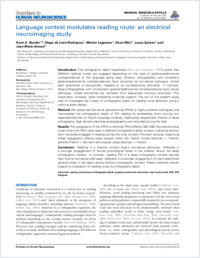Language context modulates reading route: an electrical neuroimaging study
- Buetler, Karin A. Neurology Unit, Laboratory for Cognitive and Neurological Sciences, Department of Medicine, Faculty of Science, University of Fribourg, Switzerland
- Rodríguez, Diego de León Neurology Unit, Laboratory for Cognitive and Neurological Sciences, Department of Medicine, Faculty of Science, University of Fribourg, Switzerland
- Laganaro, Marina Faculty of Psychology and Educational Sciences, University of Geneva, Switzerland
- Müri, René Division of Cognitive and Restorative Neurology, Departments of Neurology and Clinical Research, Inselspital, University Hospital, University of Bern, Switzerland
- Spierer, Lucas Neurology Unit, Laboratory for Cognitive and Neurological Sciences, Department of Medicine, Faculty of Science, University of Fribourg, Switzerland
- Annoni, Jean-Marie Neurology Unit, Laboratory for Cognitive and Neurological Sciences, Department of Medicine, Faculty of Science, University of Fribourg, Switzerland
-
20.02.2014
Published in:
- Frontiers in Human Neuroscience. - 2014, vol. 8, p. article 83
English
Introduction: The orthographic depth hypothesis (Katz and Feldman, 1983) posits that different reading routes are engaged depending on the type of grapheme/phoneme correspondence of the language being read. Shallow orthographies with consistent grapheme/phoneme correspondences favor encoding via non-lexical pathways, where each grapheme is sequentially mapped to its corresponding phoneme. In contrast, deep orthographies with inconsistent grapheme/phoneme correspondences favor lexical pathways, where phonemes are retrieved from specialized memory structures. This hypothesis, however, lacks compelling empirical support. The aim of the present study was to investigate the impact of orthographic depth on reading route selection using a within-subject design.Method: We presented the same pseudowords (PWs) to highly proficient bilinguals and manipulated the orthographic depth of PW reading by embedding them among two separated German or French language contexts, implicating respectively, shallow or deep orthography. High density electroencephalography was recorded during the task.Results: The topography of the ERPs to identical PWs differed 300–360 ms post-stimulus onset when the PWs were read in different orthographic depth context, indicating distinct brain networks engaged in reading during this time window. The brain sources underlying these topographic effects were located within left inferior frontal (German > French), parietal (French > German) and cingular areas (German > French).Conclusion: Reading in a shallow context favors non-lexical pathways, reflected in a stronger engagement of frontal phonological areas in the shallow versus the deep orthographic context. In contrast, reading PW in a deep orthographic context recruits less routine non-lexical pathways, reflected in a stronger engagement of visuo-attentional parietal areas in the deep versus shallow orthographic context. These collective results support a modulation of reading route by orthographic depth.
- Faculty
- Faculté des sciences et de médecine
- Department
- Médecine 3ème année
- Language
-
- English
- Classification
- Biological sciences
- License
-
License undefined
- Identifiers
-
- RERO DOC 209414
- DOI 10.3389/fnhum.2014.00083
- Persistent URL
- https://folia.unifr.ch/unifr/documents/303581
Statistics
Document views: 130
File downloads:
- pdf: 179
